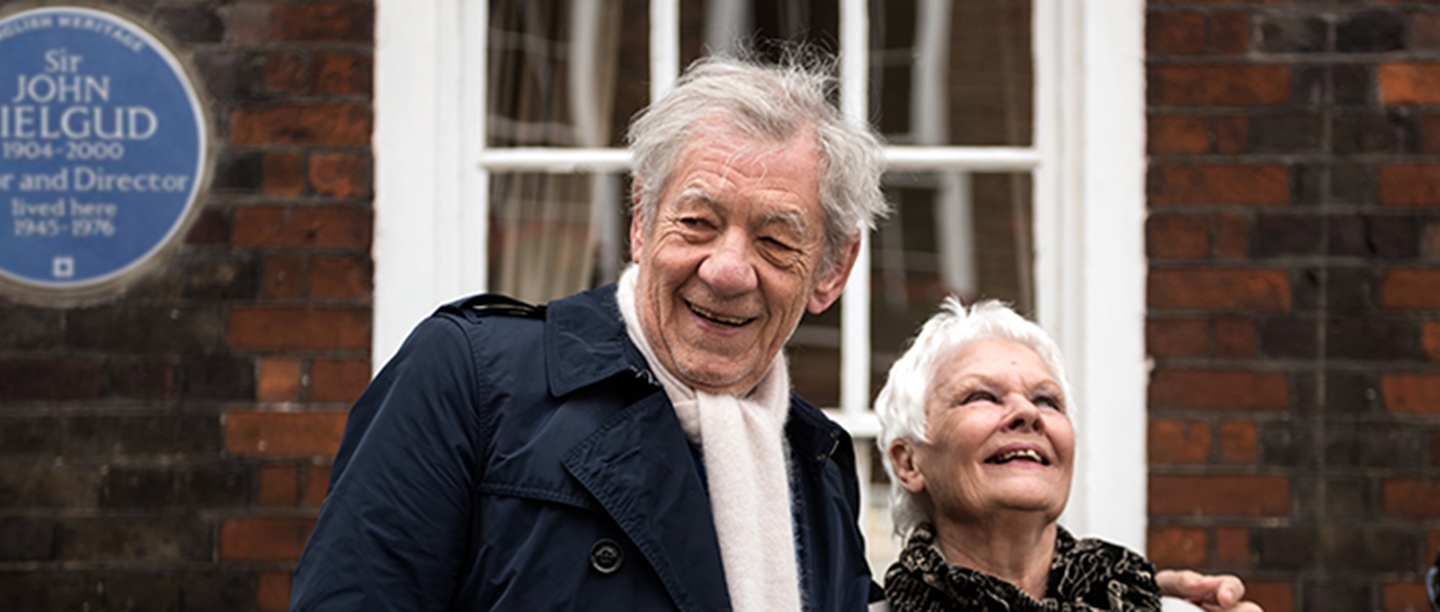
Dame Judi Dench wants visitors to London to pause in reflection when they see an English Heritage blue plaque – and she practices what she preaches. After unveiling a plaque for her friend and fellow actor Sir John Gielgud she did just that.
Gielgud was one of a handful of artists to receive an Oscar, a Grammy, an Emmy and a Tony. I spoke to Dench outside Gielgud’s former home at 16 Cowley Street, Westminster, to discuss his legacy and the importance of preserving the heritage of the London arts.
Dame Judi Dench shares her memories of John Gielgud.
Dame Judi Dench was overwhelmed. You could see it in her body language as she stood listening to the memories of Sir John Gielgud shared by the speakers preceding her. At times she held her scarf to her face and stared towards the ground, while at others she lifted her chin and giggled.
I was in illustrious company. As well as Dench, the speakers at the unveiling included many of Gielgud’s peers such as writer and director Sir David Hare; actor, writer and director Michael Pennington and actor John Miller, who proposed the plaque to English Heritage. It was a surprise to many of us when Sir Ian McKellen – who joined our celebration of the blue plaque’s 150th anniversary last year – passed by and joined us.
When it was Dench’s turn to speak, and later pull the string attached to the plaque’s red curtain, she admitted the difficulty – and delight – at her involvement. She reminisced about the times Gielgud would get her in to trouble for laughing on stage and how kind he was to her during her early days as an actress.
‘I feel overwhelmed to be doing this job today,’ she told the crowd of 50 media representatives and invited guests, neighbours and curious passers-by.
‘I make it no secret how much I loved John – I really, really loved him.’
Sir John Gielgud is one of a select few to receive an Oscar, a Grammy, an Emmy and a Tony. Photograph taken in 1969. © National Portrait Gallery, London
Blue plaques and the London legacy
Standing underneath the plaque, I spoke to Dench following the unveiling. She told me she was delighted that the blue plaques scheme serves as a reminder of the contribution to London life made by many of her friends and peers.
‘So many friends recently this year itself – and we’re only at the end of April – have already died. Tim Pigott-Smith, who I’ve just finished filming with, died just a couple of weeks ago – and the legacy that they’ve all left is so great,’ she said.
‘If people want to find out about our history and the history of the theatre, to go and just stand for a minute outside and look at a house where you know that that person has lived – I think that’s just wonderful,’ she said.
Dame Judi Dench pulls the curtain cord to reveal Sir John Gielgud’s blue plaque.
How Gielgud rescued a young Dench
Dench described Gielgud as ‘an absolutely glorious man’ and told me how much of an inspiration he was to her.
‘We can learn so, so much from him; he was such a skilled man,’ she said.
‘I was in The Cherry Orchard with John and Dame Peggy (Ashcroft) and I had a very hard time with the director and it was Sir John who came to my rescue and he said ‘oh, if you’d been doing that for me I’d be delighted’ and I thought ‘oh, that’s who I’d do it for then’.
‘He was really an unbelievable friend and got me into terrible trouble on stage because he used to laugh a lot and I’m not good at containing myself. I really owe him, I used to see him quite a lot and I just miss him terribly.’
I asked Dench what she thought Gielgud would think about his blue plaque.
‘I expect he’d laugh a great deal and have something wonderfully witty to say about it,’ she said.
‘He’d make a wonderful joke of it because he was always rather embarrassed. It was difficult to pay him a compliment because he would turn it and pay it back to you, or he would just laugh it off.’
John Miller, Sir David Hare, Dame Judi Dench and Michael Pennington stand beneath Sir John Gielgud’s blue plaque after the unveiling.
In good company: find more blue plaques nearby
‘Dear old Cowley Street’, as Gielgud referred to his first home and residence of more than 30 years, is a quiet street tucked behind Westminster Abbey in central London. Gielgud lived here between 1945 and 1976. A few doors away are other blue plaques commemorating the first Director-General of the BBC, Lord Reith, and author and intelligence officer T.E Lawrence. A neighbour who arrived to watch the unveiling told me the current residents host street parties for their families, indicating the warmth of a prestigious neighbourhood Gielgud was once a part of.
I left Dench to celebrate Gielgud and took a moment to reflect on the plaque myself. Dench was right, the significance is overwhelming.
Sir John Gieldgud leaves Buckingham Palace with his sister and mother after receiving his knighthood in 1953. © Bettmann/Getty Images
About the blue plaques scheme
Gielgud is one of more than 900 people who have lived or worked in London to be commemorated with a blue plaque. The scheme celebrated 150 years last year and is the oldest scheme of its kind in the world.
For more information about blue plaques visit our blue plaques page.
Find more blue plaques around London and learn about your favourite figures and unsung heroes with our free app. Download the app now from the Apple App Store for iPhone or the Google Play Store for Android.


